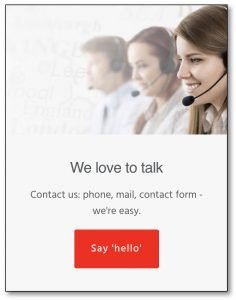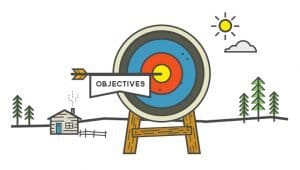7 expensive mistakes you must not make with your website
…and how to avoid them
I have have worked with a lot of small business websites throughout Hertfordshire and further afield.
I’ve seen some painful mistakes repeated again and again. These mistakes can cost you a lot of time, effort and money.
Take a read through this article and keep them in mind while you work on your project with your web design company. Why not learn from others’ mistakes?
Failing to use responsive design
Firstly, what is responsive design? More than half of all searches are conducted on smartphones now. Your website design simply must work well across smartphone, tablets and desktop.

The go-to industry standard on this is called responsive design – it simply means that the content is re-sized and re-ordered to work brilliantly no matter the dimensions of the device the user is using.
Ignore this and two things will happen for sure. One, your customers will leave you when on smartphones phones (did I mention that this is more than half of all searches?). Two, Google will demote you in its search results. Google wants to deliver amazing customer experiences and therefore is passionate about making sure the sites that work well on all devices are the ones it will serve up to its searchers.
Don’t allow you competitors to take advantage: if your website is not responsive, even if you have a separate mobile version of your site, you need to address this urgently.
Calls to action missing or fluffed
A call-to-action (CTA) is simply a piece of website content designed to encourage users to perform an action – e.g. buy now button, sign up box.

I’ve seen way too many sites for way too many customers with either no CTA’s or CTA’s buried away in the middle of the text. Your customers need your help. Don’t assume they will painstaking figure out how to progress with you. If it’s not obvious, they will give up and go elsewhere.
You need to help your website visitors by guiding them through your site and encouraging them to engage with you. Put clear buttons throughout the site, include forms in content where its appropriate. Make it simple and clear and you will be rewarded by your customers.
Designed for your designer not your customers
Of course your new or updated website needs to look amazing. No-one loves a jaw-dropping website design more than me!
However, please keep in mind your visitors are coming to you to find out about your small business, your content, your amazing unique story and how it can fit into their lives.
Over-engineered design, too much detail, graphics for graphic’s sakes, not enough white space all distract from this and have your visitors disappearing off for good. And don’t get me started on web development that has things bouncing across pages. All these things can look cool, and used in the right context will impress your visitors, but too much and they’ll get a headache.
Keep in mind your content is king: what’s your amazing story and what’s your voice. Start with this and then let the design show it off in the best possible light.
Designed for you not your customers
You know and love your small business I’m sure. Are you maybe a bit too close? I know it’s wonderful to tell customers the year your company started, your family’s story and bring across your passion. There is a place for this for sure. However, make sure you are not doing this at the detriment to customers finding out what they want to know when they land on your site.

Take a step back and make sure you’ve designed your website user experience for your user. What questions do they ask you? What do they need to know so they can go ahead and work with you?
I always encourage customers to start the design process here away from screens and distraction and start mocking this up with good old fashioned pen and paper. You probably have a number of different things customers may want to know, e.g. what are your opening hours, what’s your price, where are you based, etc. Think about how to address each of these needs.
I’d also encourage you to think carefully about the words you use. I worked with a local authority who had things called household waste recycling centres. Trouble was, all their customers called them ‘the dump’ or ‘the tip’ so they didn’t have a clue how to find what they wanted. Think about it from the perspective of your customers.
Have you jargon-checked your content? Have you made sure you’ve really thought about your user. Better yet, have you tested it with real users?
How this works with search is also vital (this could be a whole new article in itself). Suffice to say it is of course crucial to think about how the content will rank in Google’s search results.
In my view, this is an area where you will be well rewarded to take some professional advice – an experienced expert will get your site not just looking good, but also performing the way you need it to.
Using a free website template builder
There a more and more offer companies offering “drag-and-drop” website builder apps that claim to allow users to launch a new website in minutes using free template software.
These potentially have a role for local groups who just want to publish a phone number and location (although I’d argue Google My Business pretty much has this covered now).
These are not suitable for business owners however. The sites almost invariably end up looking awful and there is little or no search engine optimisation built in so your site never gets found.
These sites load slowly too as the templates send a lot of information to your users’ machines and the images have not been handled professionally. And as we covered already, this has your customers leaving you and Google demoting you in its search results.
Not to mention that it’ll likely drive you mad even getting to that bad place.
I’ve had to pick up abandoned sites way too often from these – do yourself a favour and have a chat with a professional before you go down this path, it could save you a big headache.
If you are working on a tight budget, have a chat with us about our premium, professional template solutions. You can have an amazing site that is customised to make it unique to your business and your story that you can achieve for a relatively small investment.
Not starting with the end goal in mind at the start
Start with your objectives. Write them down. Come back to them regularly as they should be your true north.
Beautiful websites make us happy so designs should ‘wow’ us. But you likely started your project with a goal: more sales, better click through rate on contact forms, new members etc.

Finally, make them measurable. This is particularly true if you have an existing website. Check your Google Analytics data to see your current baseline performance. Then you can see the payback from the investment.
You can even use this to think about the budget for the project – e.g. let’s say you are a small business getting 20 contact forms from your site at the moment, you convert 10% of them, and the customer lifetime value from each is £500.
It’s pretty easy to see that if you can get a 10% improvement to the number of contact forms it will be worth £52,000 per annum (20 contacts/week*10% improvement = 2 contacts/week * 52 weeks * £500).
Let’s say you spend £2,000 on your project, and you should get a lot for that, that’s a 26x return in the first year. Now, that’s something to shoot for.
Planning
To fail to plan is to plan to fail?

So, plan ahead. Where do you want your site to take you in 1, 2, 5 years? If you are a village book club then a free website template builder from one of the hosting providers may do everything you need. There may be some design compromises, but that’s ok.
However, if you are a small business looking to grow, then you want a website that can grow with your needs. I love WordPress for this, it can do pretty much everything you’ll ever need it do, you own the content on there (unlike the templates where the host has the content) and you can change providers any time you need.
Key here is to consider you needs properly and get the right advice from a good professional.
Wrap up and what next?
And that makes a nice link to my final note (and it’s time to heed my own advice and include a call-to-action). If you want to ask any questions or just have a chat, please hit the button below. We love a no-strings-attached conversation to make sure you are on the right track.


